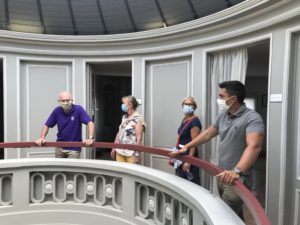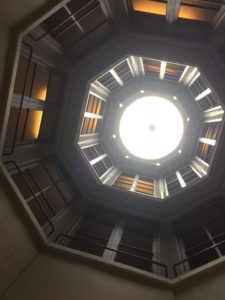In which Sid and Doris leave Boulogne, visit Le Havre and stay in Rouen.
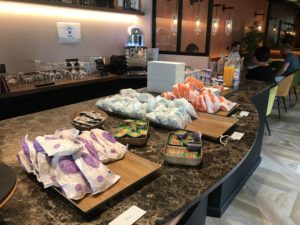 After a meticulously-organised Covid-compliant breakfast buffet, our timed ticket for Le Havre’s Maison de l’Armateur is for 3.30pm so we have time to use the N roads as well as some autoroute. N stands for Nationale but could as well stand for Napoleonic as the network of very straight roads as ordained by the Corsican. Of course the roads on Corsica offer no such opportunity as these rolling northern departments. Hermann loves these roads, now limited to 80 kph. And who would not want to go via Wailly Beaucamp and Vron.
After a meticulously-organised Covid-compliant breakfast buffet, our timed ticket for Le Havre’s Maison de l’Armateur is for 3.30pm so we have time to use the N roads as well as some autoroute. N stands for Nationale but could as well stand for Napoleonic as the network of very straight roads as ordained by the Corsican. Of course the roads on Corsica offer no such opportunity as these rolling northern departments. Hermann loves these roads, now limited to 80 kph. And who would not want to go via Wailly Beaucamp and Vron.
Doris mixes in some Autoroute, which are really just rural dual carriageways with not many junctions. Perhaps it is just because this is a Saturday, or because we are wafting along at 55 mph with the roof down, but it seems less fraught than British motorways. We even have time to peer over the edge of the viaduct at Neufchatel to spot the Avenue Verte which we cycled down to Paris with our CTC group a few years ago.
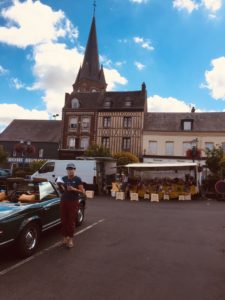 In France there is every chance a shop will be shut when you most want it. So we stopped early and this picture at Yerville can stand for much that is lovely in Normandy. Doris is holding a baguette sandwich, Orangina and fabulous fruit tart. Behind we have the flower wagon to which a local delivers about a hundredweight of gladioli and some non-Covid-compliant bristly kisses. Behind them a properly beamed house in brown and cream with the church spire behind. There is Yerville. Thus replenished the duo march on Le Havre.
In France there is every chance a shop will be shut when you most want it. So we stopped early and this picture at Yerville can stand for much that is lovely in Normandy. Doris is holding a baguette sandwich, Orangina and fabulous fruit tart. Behind we have the flower wagon to which a local delivers about a hundredweight of gladioli and some non-Covid-compliant bristly kisses. Behind them a properly beamed house in brown and cream with the church spire behind. There is Yerville. Thus replenished the duo march on Le Havre.
It takes a while to fill Hermann with petrol, partly because he has an 80 litre tank and partly because he has a bad habit of burping all the petrol back up if you try to fill him too quickly. So while Sid settles down for 5 minutes of careful squirting, Doris gets chatting to the Brit behind us in the queue who is driving a camper van. He is very happy to be waiting for such a handsome car to be filled and it turns out he is a petrolhead too, in fact he campaigns F3 cars at the moment, even though he, like Sid, may be above the average age for such motorsport activity. And that is why Sid and Doris are sending a big hello from their blog to Malcolm Scott
https://www.f3cup.co.uk/drivers/2017/malcolm-scott/.
Le Havre has been marched on before. To repair the harm Augustus Perret was appointed guiding mind for the rebuilding after the Liberation which involved much Destruction. One of his best known buildings is the Theatre des Champs Elysees from 1913, an Art Nouveau style along way from the simplicity of the Le Havre shapes 35 years later. We drove around the main square en route for what seems to be the last old building in the port, the Maison de l’Armateur.
The architect Paul Michel Thibault had made his name with the fortifications for the town. Three existing houses backed onto the plot. In order to let natural light into the house he built it around a light well, and it therefore qualifies for today’s #kindnessandingenuity exhibit.
Bought by Martin Pierre Foache, our merchant, the ground floor was used as a shop. Sadly the turntable for horse drawn wagons has been removed. The next floor is for the kitchens and all above there is beautifully laid out for domestic life (though a maison secondaire) and entertaining. Le Havre was one of the ports to benefit from the Triangular Trade of trade goods to Africa, slaves to the French colonies and coffee home, which is clearly explained and not glossed over.
The light well was later fitted with a glass domed roof and water collected so the kitchen had running water. Previously the water just fell through the middle of the house, which may have been quite useful if they’d had horses on the ground floor. We include here a picture of people having a tour wearing masks – quite a novelty on day one but something that will probably pall over the next few weeks.
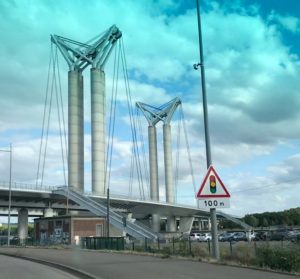 The afternoon finished with a run to Rouen, and while Sid and Doris dearly love over-decorated churches what they really like is an enormous lifting bridge. The Seine is navigable and Rouen is visited by tall ships yet needs road traffic to cross bank to bank. The answer is this huge bridge built with much input from the team that built the Stade de France. It was opened in 2007. There are still Seine river crossing ferries, maybe next time.
The afternoon finished with a run to Rouen, and while Sid and Doris dearly love over-decorated churches what they really like is an enormous lifting bridge. The Seine is navigable and Rouen is visited by tall ships yet needs road traffic to cross bank to bank. The answer is this huge bridge built with much input from the team that built the Stade de France. It was opened in 2007. There are still Seine river crossing ferries, maybe next time.
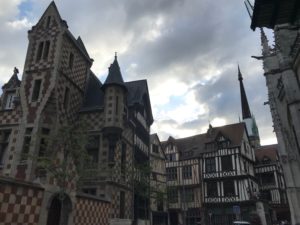
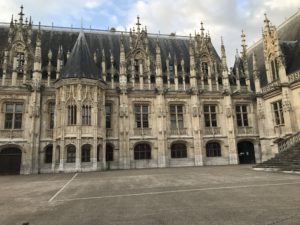
In the evening, after a short walking tour of the town to stare at the mediaeval bits and frilly carvings, we try to eat local but the restaurants wanted to shut so we found a Lebanese eaterie. France was gifted the Lebanon after WW1, so we counted it quite local. The beer was awful but all the mezzes probably made up for it.
 After a meticulously-organised Covid-compliant breakfast buffet, our timed ticket for Le Havre’s Maison de l’Armateur is for 3.30pm so we have time to use the N roads as well as some autoroute. N stands for Nationale but could as well stand for Napoleonic as the network of very straight roads as ordained by the Corsican. Of course the roads on Corsica offer no such opportunity as these rolling northern departments. Hermann loves these roads, now limited to 80 kph. And who would not want to go via Wailly Beaucamp and Vron.
After a meticulously-organised Covid-compliant breakfast buffet, our timed ticket for Le Havre’s Maison de l’Armateur is for 3.30pm so we have time to use the N roads as well as some autoroute. N stands for Nationale but could as well stand for Napoleonic as the network of very straight roads as ordained by the Corsican. Of course the roads on Corsica offer no such opportunity as these rolling northern departments. Hermann loves these roads, now limited to 80 kph. And who would not want to go via Wailly Beaucamp and Vron. In France there is every chance a shop will be shut when you most want it. So we stopped early and this picture at Yerville can stand for much that is lovely in Normandy. Doris is holding a baguette sandwich, Orangina and fabulous fruit tart. Behind we have the flower wagon to which a local delivers about a hundredweight of gladioli and some non-Covid-compliant bristly kisses. Behind them a properly beamed house in brown and cream with the church spire behind. There is Yerville. Thus replenished the duo march on Le Havre.
In France there is every chance a shop will be shut when you most want it. So we stopped early and this picture at Yerville can stand for much that is lovely in Normandy. Doris is holding a baguette sandwich, Orangina and fabulous fruit tart. Behind we have the flower wagon to which a local delivers about a hundredweight of gladioli and some non-Covid-compliant bristly kisses. Behind them a properly beamed house in brown and cream with the church spire behind. There is Yerville. Thus replenished the duo march on Le Havre. The afternoon finished with a run to Rouen, and while Sid and Doris dearly love over-decorated churches what they really like is an enormous lifting bridge. The Seine is navigable and Rouen is visited by tall ships yet needs road traffic to cross bank to bank. The answer is this huge bridge built with much input from the team that built the Stade de France. It was opened in 2007. There are still Seine river crossing ferries, maybe next time.
The afternoon finished with a run to Rouen, and while Sid and Doris dearly love over-decorated churches what they really like is an enormous lifting bridge. The Seine is navigable and Rouen is visited by tall ships yet needs road traffic to cross bank to bank. The answer is this huge bridge built with much input from the team that built the Stade de France. It was opened in 2007. There are still Seine river crossing ferries, maybe next time.